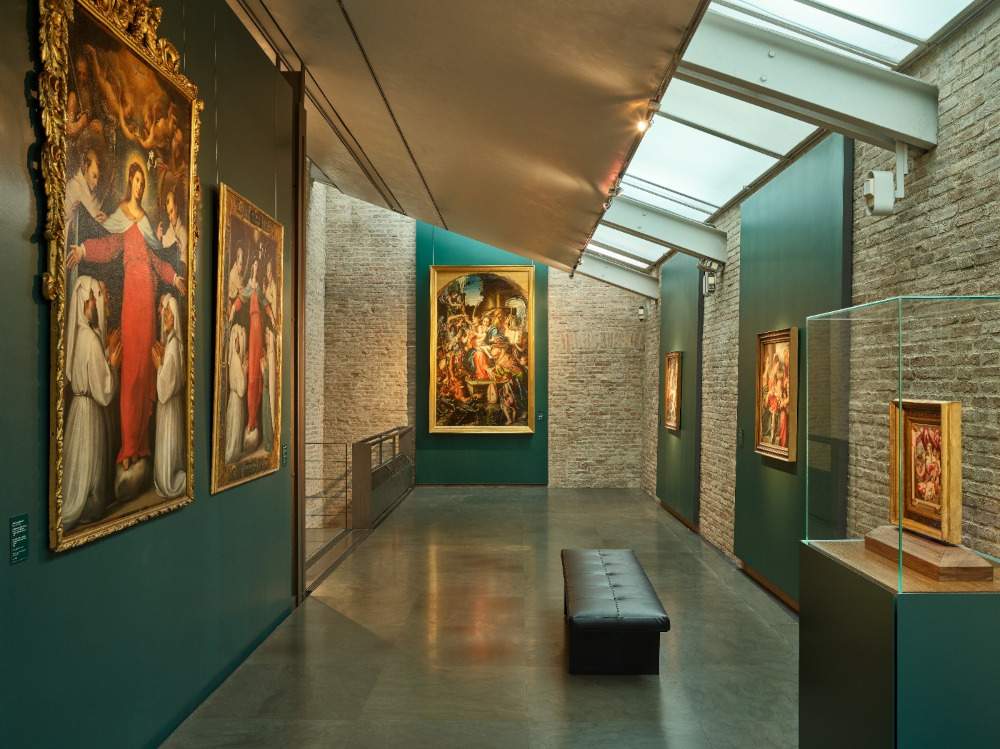Parma ’s Complesso Monumentale della Pilotta today inaugurates the new exhibition itinerary of theNorthwest Wing of the National Gallery, starting with an unprecedented itinerary dedicated to Flemish painting from the 15th to the 17th centuries. Over 2,000 square meters rearranged and redesigned to offer better visibility of the works housed there. More than twenty works in this new section, and as many frames, have undergone restoration to give full legibility to masterpieces long kept in storage and now on display for the first time to the general public, as well as placed in comparison with Mannerist art in the duchy.
Among the main objectives of the refitting of the second floor of the Northwest Wing of the National Gallery of Parma is the desire to restore full dignity and prominence to Flemish art, which plays a central role in the history of Parma art and court collecting. The paintings were mainly executed by artists who had relations with the Farnese court or liked the noble families of the area, such as that of the counts Sanvitale and Dalla Rosa-Prati.
“Flemish art was recalled to Parma to increase the prestige of the Court,” explained director Simone Verde, “thus contributing to emphasize the cosmopolitan role of the Duchy within modern Europe. Such works, painted to be seen up close, spread a new taste in interior decoration, made of preciousness in which refined images almost chiseled in matter were arranged on the walls until they filled them. In all the themes, a way of observing the reality of a culture that was markedly different from that of Italy and emerged powerfully thanks to the Spanish hegemony in Europe, which had a decisive impact on the productions of the Peninsula and accelerated the birth of Mannerism.”
Among the works in this section, the portrait of Erasmus of Rotterdam, a masterpiece by Hans Holbein from the Sanvitale collection, occupies a prominent place. Thanks to the restoration carried out by Open Care - Servizi per l’Arte, the painting has regained its original chromatic splendor, as well as the high definition of the details of the humanist’s face and figure. Also from the Sanvitale collection is an important nucleus of works made with different painting techniques but united by the Flemish miniature finesse of details and shaded landscapes: these include paintings on copper by Paul Bril and Sebastiaen Vrancx. Also, the Temptations of St. Anthony, an oil on panel painting attributed to the circle of Jan Wellens de Cock.
In addition to the work on the Brughelian-inspired Market Scene, also noteworthy are the restoration of Aert Anthonisz’s Naval Battle, a small-scale work illustrating a furious battle in which the vessels are accurately depicted, as are the as are the crowds of soldiers on board, and that of Interior of St. James’s Church in Antwerp by Hendrick van Steenwyck the Younger, which has regained not only its harmoniously played chromatic tones of yellow and pale pink but also its perspective effects and careful description of details.
Thanks to the intervention of theIstituto Superiore per la Conservazione e il Restauro, two valuable panels by Jan Provost, among the most significant exponents of the Bruges School, depicting St. Jerome and St. John the Baptist, are returned to the public for the first time; they are probably the upper doors of a triptych, of which the central part is unknown, dating within the first decade of the 16th century. Instead, the six canvases with scenes from Jan Soens’ Genesis, in which the description of a lush nature is conceived according to the characteristics of Flemish landscape painting, come from the Dalla Rosa Prati collection.
Among the Flemish paintings of religious subjects that came to the Gallery from the same collection, two paintings by the same author stand out: the Saint Cecilia by Denys Calvaert and the Deposition, which entered the Gallery in 1851 with the purchase of the Dalla Rosa-Prati collection promoted by Duchess Maria Luigia. The room also displays the portrait of the governor of Flanders Alessandro Farnese executed in 1557 by Anthonis Mor.
The exhibition tour continues on the second floor in the section Art in Parma 1500-1600, which testifies to the presence of additional personalities and new influences, particularly Flemish, also due to the circulation of prints and engravings from the north, in addition to the painting of the early 16th century in Parma. Among them emerge, in particular, Giorgio Gandini del Grano, a still little-known author, Orazio Samacchini and Giovan Battista Trotti.
A tribute to Parmigianino’s art, but charged with new accents, is also found in the fresco fragments by Jacopo Zanguidi, known as Bertoja, from the Palazzo del Giardino intended by Ottavio to house the leisure and entertainment of the court. In the decoration of the piano nobile fairy tales and amorous subjects from the chivalric poems of Boiardo and Ariosto follow one another on the walls in a continuous narrative, rich in fantastic inventions and Parmesan formal elegances, to which they are interwoven with the experiences inferred from the magical realism of Germanic and Flemish painting by painters who came from the north, whose significant presence in the city was also due to the court’s relations with Flanders and in particular with Margaret of Austria, who had become governor of the Netherlands since 1559.
Image: View of the hall of Parma Mannerism. Photo by Giovanni Hänninen
 |
| Parma, new Pilotta rooms dedicated to Flemish painting and Parma Mannerism inaugurated |
Warning: the translation into English of the original Italian article was created using automatic tools. We undertake to review all articles, but we do not guarantee the total absence of inaccuracies in the translation due to the program. You can find the original by clicking on the ITA button. If you find any mistake,please contact us.